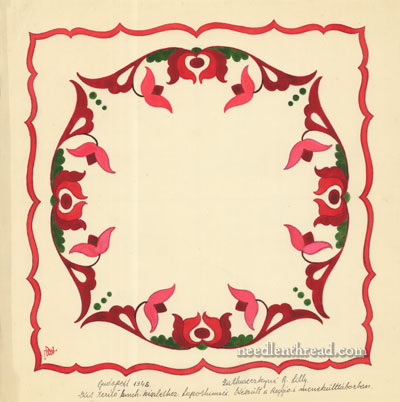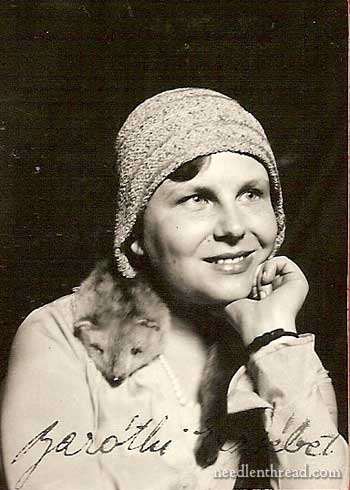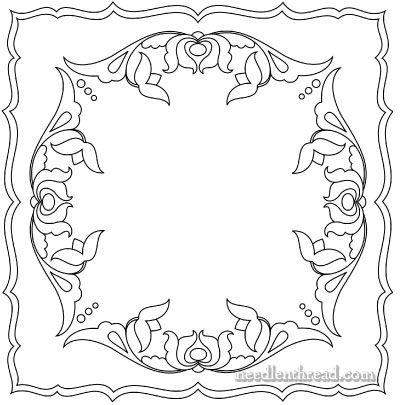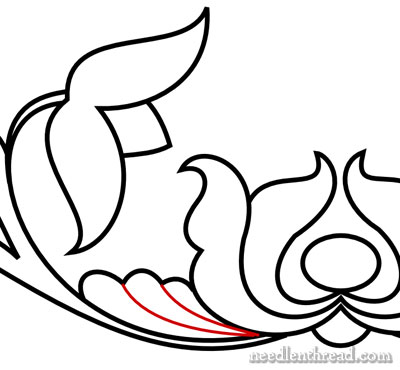Last week, I introduced you to the embroidery design work of Lilly Baróthi Zathureczky and told you a little bit of Lilly’s life story. Today, I’d like to share with you another one of her designs!
It’s hard for me to pick “favorites” from the various designs she drew – I find all of them enchanting in some aspect or another. On this particular design, I love her choice of colors, the somewhat delicate floral and swash that makes up the interior circular design, and I like the wavy edge around the perimeter. (In fact, what’s not to like about it?!)

Just like the Golden Circle pattern (the first Hungarian embroidery design in this series), this one is suitable for traditional Hungarian folk embroidery techniques, but it is also adaptable to all kinds of other embroidery techniques – whitework, goldwork, blackwork, silk…. there are heaps of possibilities for adaptations! An enlarged version of the design would work well for a tea cloth (a small table cloth – maybe 25″ – 28″ square), and a smaller version (for example, 14″ square) would work well for a doily or decorative linen for the center of a table. The design could also be worked as a pillow, or, very small, as a decorative insert for the top of a box.

Here’s a picture of Lilly from 1932 – looking young, idealistic, and adventurous! At this time in her life, she was traveling with her father throughout Europe and beginning to develop a portfolio of designs that were mostly embroidery related. If you’d like to read a brief sketch of her life, you can find it with the first Hungarian embroidery pattern posted in this series, the Golden Circle.

This is the line drawing of the design above. I’ve restricted the lines to the areas of color where Lilly drew her original outlines, but there are some parts of the design where you can definitely add other guidelines for stitching. For example, in this close-up of the main motif in the design, I drew in some extra lines, in red:

In the folk embroidery of Hungary, many of the design elements are split into these elongated petal shapes, which are stitched either with either satin stitch or buttonhole stitch, so dividing different parts of the design like this would not be too unusual.
For printing, here’s the PDF version of today’s design. It will definitely need enlarging if you plan to work it as a doily, or even more so if you plan to work it for the center of a tea cloth. Any copy center can help you get a good enlargement, if you are unable to do so on your home printer.
Hungarian Embroidery Design #2: Floral Square (PDF)
Finally, a request: if you do happen to make use of any of Lilly’s designs for your embroidery (or other craft) projects, I’d love to see a photo of what you do with them, and so that your work can be a part of the collection of Lilly’s Legacy.
Thanks again to Mike Parr and Guy Brassard for sharing Lilly’s Legacy!
Looking for inspiration & information on hand embroidery?
There are all kinds of reasons to sign up for the Needle ‘n Thread daily newsletter! Check them out and sign up today!







Thank you Mary for sharing these patterns. I`m Hungarian, but I didn`t knew Lilly Baróthi Zathureczky.
The description on the picture in Hungarian says, it`s a pattern for an embroidery kit for satin stitching, made in the refugee camp in Reggio E.
The first pattern you shared was designed for inlay for wood craft and/or for decorating an altar. But I agree, it is also adaptable to embroidery techniques.
I’d love to see the projects from others too.
Thank you again 🙂
Thanks, all, for your comments! I’m glad you like the design and can find many uses for it!
Meg – great idea about the applique!
Wassernixe – Thanks so much for the translation of the writing on the designs! That is very helpful!!
Mike – thanks for the additional info on the Turkish influence! Interesting how styles get mixed up, isn’t it?
Enjoy the design!
MC
Thank you Mary!
When I saw Lilly’s design today I thought that it would make a perfect project to add to the pomegranate corners I am working on now. I am doing a center piece “doily” for the table with the pomegranate, this one will only add to it…Thank you!
Well, time for me to get back to stitching!
I wanted to point out the strong Turkish influence in this design, similar to Turkish tiles. The exaggerated tulips point to that. Hungary was annexed by the Ottoman empire in the mid 1700’s so the Turkish influence crept into the folk design elements and stayed there forever afterward.
With very little fixing that would make a pretty medallion for a very traditional applique quilt or plain fabric just quilted.
Thanks for the inspiration!
Mary- I see Lilly’s Legacy as being turned into quilt blocks, in applique.
I plan to make them into felt applique pillow blocks, jumbo sized. Thanks, Mary, I needed these!
Mary, this design is lovely. I especially like the colours and the delicate simplicity of the overall pattern. As Meg pointed out it would be perfect for applique.
Lilly’s story was touching and I thank you for sharing it on your website. Loved seeing the photo of Lilly!!
Cheers,
Linda A
Ontario, Canada
Mary,
You’re awesome! How cool of you to give this woman’s legacy a new life, and enrich someone else’s who might only need just the right inspiration. Thank you – Lily’s work is really lovely and it’s great to see it, along with your suggestions for further application. 🙂 I haven’t commented in awhile, but love popping in to see how your Cluny tapestry and other assorted projects are moving along. Have a great day!
Another wonderful design! And I just realized something – how did she get each repeat so….repeated? Did she sketch the first, then trace the others? If she did it all freehand, I’m even more in awe of her talent.
Hi Mary,
Thank you so much for sharing Lily’s legacy. Like a few of the ladies in the above comments, I saw Lily’s first and now second design as applique blocks. I am about half way done with the first design in applique and will share a photo once it is complete. These designs are so wonderful and I look forward to seeing more of them.
Thank you
Jean
My last name is Zathureczky. I too live in Canada. I am making the assumption that I could be related to Lilly. Do you have more information about her and her family?
Hi,
I am Hungarian and i need to tell it is a mixture of design as it does not belongs anywhere. There is a french motif and the tipical tulip motif as well. I so disagree with Mike that we have a lot of turkish influence. As yes we have but i need to tell that tulip motif can come from indian culture as we have came from that area. Hungarians did not like the turkish culture and they were always trying to keep their own identity. If you look into how many emroidery design exist within Hungary you will see the turkish influence does not count anymore.